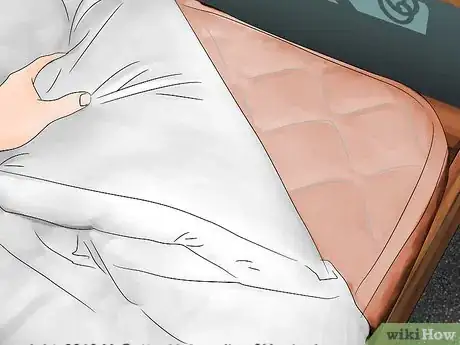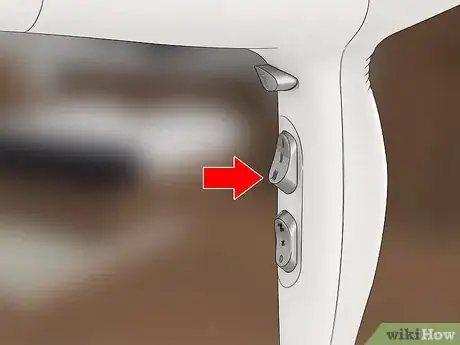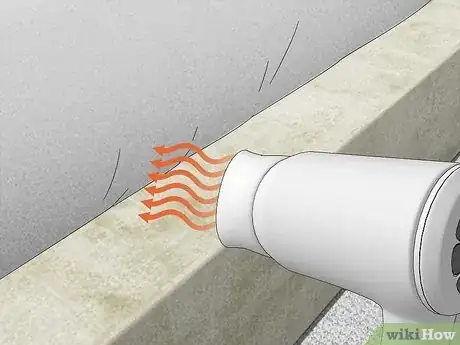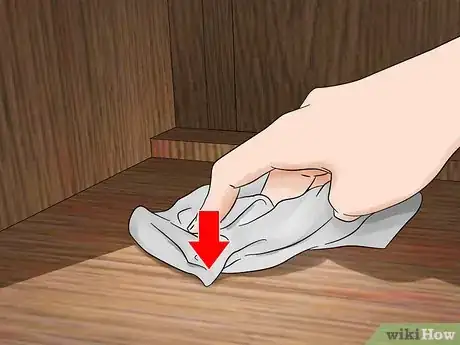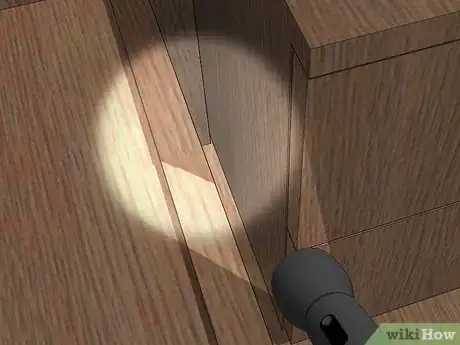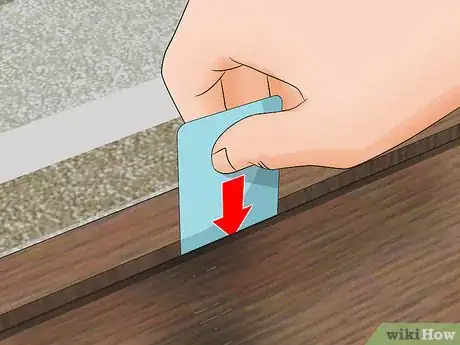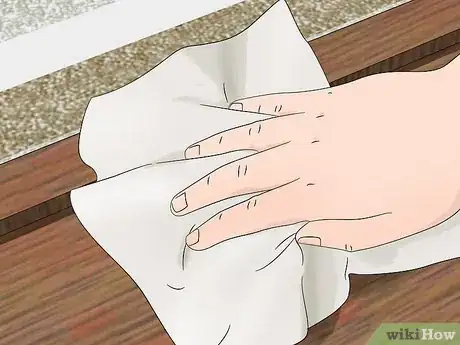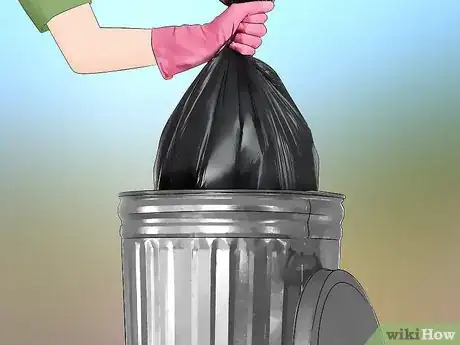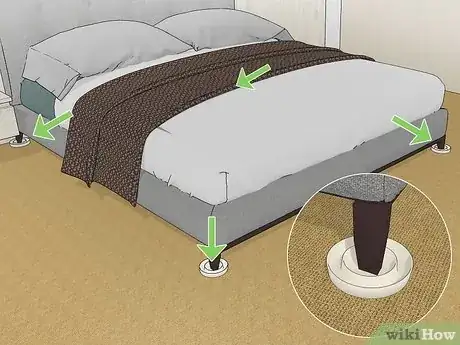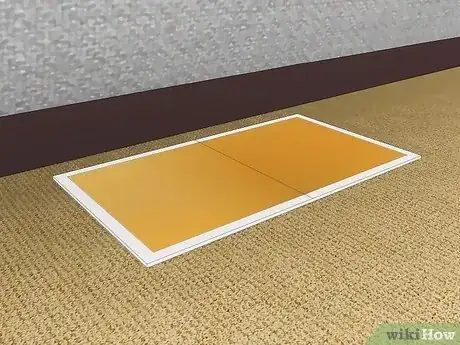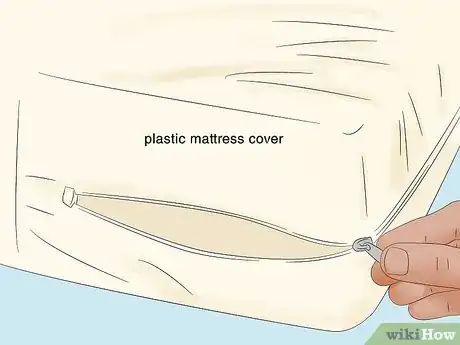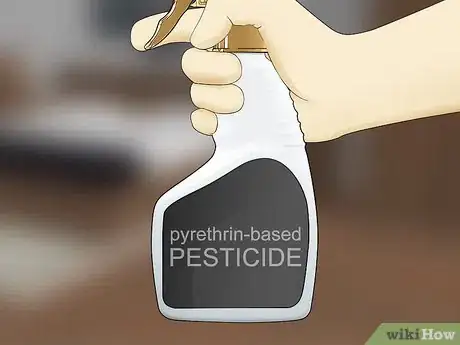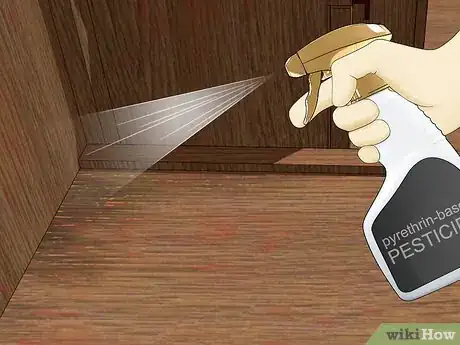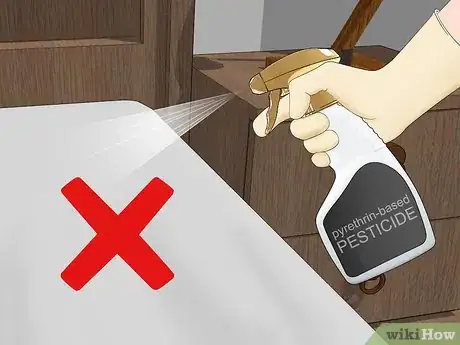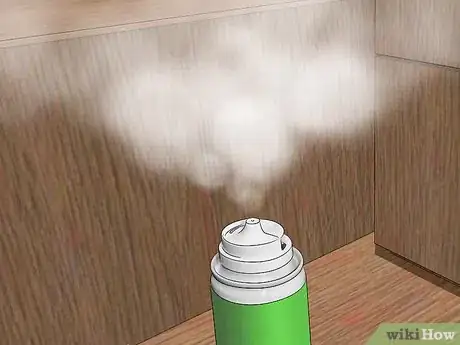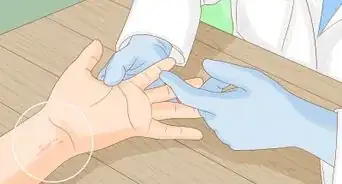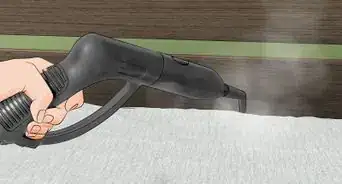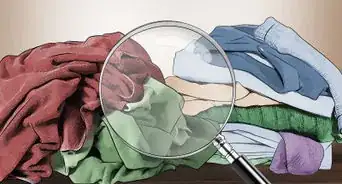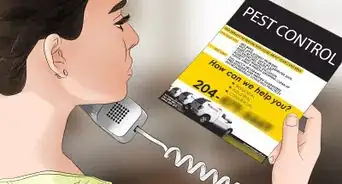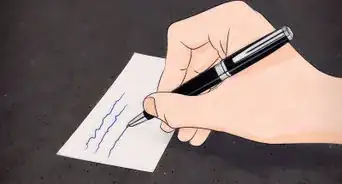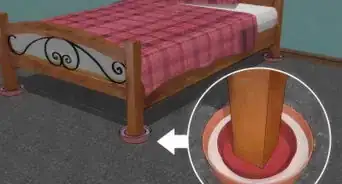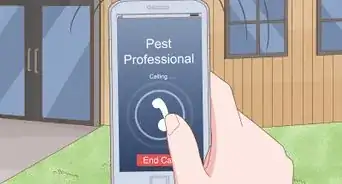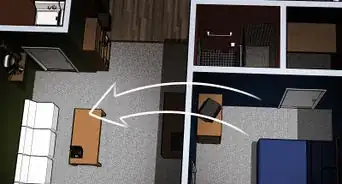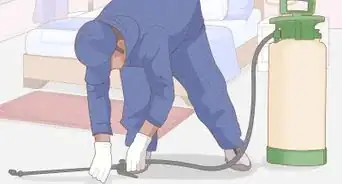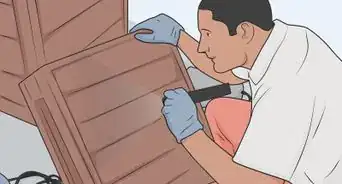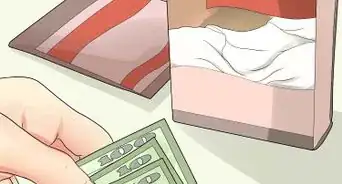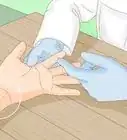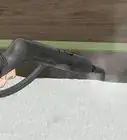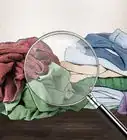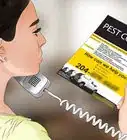This article was co-authored by Kevin Carrillo and by wikiHow staff writer, Hannah Madden. Kevin Carrillo is a Pest Control Specialist and the Senior Project Manager for MMPC, a pest control service and certified Minority-owned Business Enterprise (MBE) based in the New York City area. MMPC is certified by the industry’s leading codes and practices, including the National Pest Management Association (NPMA), QualityPro, GreenPro, and The New York Pest Management Association (NYPMA). MMPC's work has been featured in CNN, NPR, and ABC News.
There are 14 references cited in this article, which can be found at the bottom of the page.
This article has been viewed 171,583 times.
Do you have a bed bug infestation? These nocturnal critters (meaning they come out to feed at night) can be difficult to spot during the day, especially since they’re so small. Fortunately, they aren’t invincible, and with some crafty tricks and a little know-how, you can drive bed bugs out of hiding fast. Keep reading to learn how to track a bed bug infestation and get rid of these pesky insects once and for all.
Things You Should Know
- Use a hair dryer to flush bed bugs out of their hiding places with heat.
- Or, turn off the lights and use a credit card or piece of cardboard to scrape bed bugs out of cracks and crevices.
- Set up bed bug traps to monitor an active infestation.
- Use indoor pesticides to kill bed bugs when they come into contact with them.
Steps
Using a Hair Dryer
-
1Hunt for bed bugs in bedding, furniture, and other likely hiding places. Bed bugs commonly conceal themselves in the contours of mattresses, the internal cavity of the box springs, and the many cracks and crevices in the bed frame. You can typically find bed bugs during the day in places like carpeting, curtain folds, electrical outlets, and furniture joints. Work your way around the room slowly, exploring each of these potential hot spots in depth.[1]
- Bed bugs are typically around 5–7 millimetres (0.20–0.28 in) long, with oval-shaped bodies and a reddish-brown hue. Younger pests may be lighter in color or even translucent if they haven't fed recently.[2]
- While they are visible to the naked eye, bed bugs are exceptionally tiny, so you'll need to look closely in order to spot an infestation. Use a flashlight in dimly-lit areas.
- Look for droppings, skin casting, and rust-colored stains as evidence of a bed bug nest.
-
2Plug in a hair dryer and set it to high heat. Be sure to hook up your hair dryer in a central location to maximize its reach. You'll be using the concentrated heat it generates to drive the bed bugs out of the hard-to-reach places where they've set themselves up.[3]
- Bed bugs are sensitive to heat, so the more intense the temperature you expose them to, the better.
- Switch the hair dryer to a low heat setting instead if you're going to be using it around plastics or other materials that might melt or warp.
Advertisement -
3Direct the heat over areas where you think bed bugs may be hiding. Hold the nozzle of the hair dryer 3–4 inches (7.6–10.2 cm) away from the suspected hiding spot and wave it back and forth slowly. If there are indeed bed bugs lurking inside, you’ll notice them making a run for it within a few seconds.[4]
- If you don't detect any signs of activity after about a minute, move on to another possible location and try again.
- The hair dryer method is most effective for forcing bed bugs out of spots where they'd be difficult or impossible to see, such as small cracks, electrical fixtures, pipes, and other openings.
-
4Crush the emerging bed bugs with a piece of toilet paper or paper towel. Cover your hand with the paper and be ready to eliminate pests as they flee from the heat of the hair dryer. It may help to use the tip of 1 finger to create enough pressure to flatten the tiny invaders in their tracks.[5]
- If for some reason you're not able to flush the paper right away, take it outside and dispose of it in a sealed trash receptacle a safe distance from your home.[6]
- Remember that paper towels shouldn't be flushed down the toilet, as this can put unnecessary strain on your plumbing or septic system.
Removing Bed Bugs by Hand
-
1Turn off all the lights in the room. Bed bugs are nocturnal animals, so forcing them out of hiding is easiest when they think it’s nighttime. Make it as dark as you can inside the home, then grab a flashlight to aid in your search.[7] Check small nooks and crannies, like on top of baseboards, inside of electrical outlets, or behind your mattress.
-
2Force bugs out of hiding with a card or similar thin object. When you spy a cluster of bugs, insert your tool into the infested space and slowly drag it towards you to scrape them out. Hold the edge of the tool firmly against the surface and angle it to cover more ground and ensure that none of the bugs have a chance to scurry free.[8]
- Ideally, the tool you use should be relatively durable. That way, you won't have to worry about it breaking accidentally.
- You probably won't be able to fish out every last pest like this, but it can be a good way to thin their numbers.
-
3Trap the exposed bugs with a piece of tape or a damp cloth. Mash the tape or cloth directly into the pests, aiming to pick up as many as you can. Due to their size, they'll have a hard time escaping from the adhesive or moist, textured cloth.[9]
- Stickier types of tape, such as duct or packing tape, are the best options.
- If you decide to go with the damp cloth approach, keep a small container of hot, soapy water nearby where you can deposit the bugs you collect.[10]
-
4Dispose of the trapped pests securely outside of your home. If you're using tape, fold the piece over on itself to make absolutely sure the bed bugs will stay stuck. If you're using a cloth, submerge it in your bucket of water and wring it out thoroughly to loosen the bugs. Throw the tape in a sealed trash receptacle outside and dump bug-filled water a safe distance from your home.[11]
- Be sure to scrub your bucket with hot water and a powerful detergent to kill bacteria left behind by bugs or their skin castings or droppings.
Using Traps
-
1Use bed bug interceptors to catch bed bugs fast. Bed bug interceptors attract bed bugs, then kill them via starvation. Set up these traps near where you’ve seen signs of bed bugs, like in your bedroom or underneath furniture. Check the traps every day and dispose of the dead bed bugs in an outside trash can.[12]
- If you often wake up with bed bug bites, place the interceptors on all 4 legs of your bed. The bed bugs will fall in naturally as they climb up or down, and they won’t be able to crawl back out.
-
2Set out sticky traps to monitor bed bug activity. Sticky traps are similar to fly paper, in that the bed bugs get stuck to them and they can’t wriggle away. These traps are good for monitoring an active infestation: set them up near where you’ve seen the bugs, then check them every day. If you find more than a dozen or so bed bugs on the traps daily, you’re still dealing with an infestation.[13]
- The best way to deal with a bed bug infestation is to call in a professional. If you’ve tried other methods and are still seeing signs of bed bugs, call a pest control company.
-
3Trap bed bugs in a mattress with a mattress cover. Bed bugs typically like to hang out on or near your mattress, since they feed on humans. If you frequently wake up with bed bug bites, strip your mattress of any sheets, then enclose it in a plastic cover. The cover will suffocate any existing bed bugs and prevent new ones from crawling in.[14]
- Keep the mattress cover on for at least 3 days to fully remove any live bed bugs.
Using Pesticides
-
1Purchase a pyrethrin- or pyrethroid-based home pesticide. Pyrethrins and pyrethroids are types of chemical compounds that are lethal to many insects. You can pick up pesticides that feature pyrethrins or pyrethroids as active ingredients at most drug stores, or in the pest control aisle of your local supermarket.[15]
- Pyrethrins are naturally-derived, whereas pyrethroids are synthetic and have been designed to act like pyrethrins. Both substances share the same purpose—to obliterate stubborn pests like bed bugs.
- If possible, track down a product that contains both pyrethroids and neonicotinoids. This particular combination has been proven to work best for killing bed bugs and preventing newly-laid eggs from hatching.[16]
- Only shop for pesticides that have been approved for indoor use. Deploying an outdoor or agricultural pesticide in your home could make you or your family very sick.
-
2Spray the pesticide anywhere you've spotted bed bugs previously. Apply the pesticide directly to the targeted area for 12-13 seconds, or just long enough to dampen the surrounding surface. Do this for every site that you believe may be harboring bed bugs. Once you've sprayed thoroughly, exit the room and allow it to air out for about 30 minutes.[17]
- Focus on places like baseboards, bedside furniture, lampshades, and nearby wall fixtures and hangings that tend to offer sanctuary to the greatest number of pests.
- Pyrethrins and pyrethroids are found in many household products, and are generally safe to apply indoors. Even so, use as little as needed to get the job done. Overexposure could result in dizziness, headache, nausea, or diarrhea.[18]
-
3Avoid using pesticides directly on or around your bed itself. Although many pyrethrin and pyrethroid-based pesticides are approved for indoor use, it's still not a good idea to deploy them where you sleep. To flush out bed bugs in your mattress or box springs, try using a hair dryer instead.[19]
- The chemical compounds in these products take longer to break down inside than they do outside, which means there's a chance they could linger and cause mild airway irritation or other uncomfortable symptoms.
-
4Hire a professional to use fogging pesticides. If you're still not sure where the bed bugs are hiding, or if you've found them in more than one place, a fogger may be the most efficient option. Call a pest control company and ask them about fogging or tenting your home. Typically, you and any children and animals will have to leave your home for a few days while the professionals do their work.[20]
- Foggers are a type of pesticide application device that release a cloud of chemicals over a larger area than you could cover using a conventional spray.
- Don't re-enter the room before the fumes have had time to clear. By doing so, you could be putting yourself at risk of inhaling harmful chemicals.
Expert Q&A
Did you know you can get expert answers for this article?
Unlock expert answers by supporting wikiHow
-
QuestionWhat draws bed bugs out of hiding?
 Kevin CarrilloKevin Carrillo is a Pest Control Specialist and the Senior Project Manager for MMPC, a pest control service and certified Minority-owned Business Enterprise (MBE) based in the New York City area. MMPC is certified by the industry’s leading codes and practices, including the National Pest Management Association (NPMA), QualityPro, GreenPro, and The New York Pest Management Association (NYPMA). MMPC's work has been featured in CNN, NPR, and ABC News.
Kevin CarrilloKevin Carrillo is a Pest Control Specialist and the Senior Project Manager for MMPC, a pest control service and certified Minority-owned Business Enterprise (MBE) based in the New York City area. MMPC is certified by the industry’s leading codes and practices, including the National Pest Management Association (NPMA), QualityPro, GreenPro, and The New York Pest Management Association (NYPMA). MMPC's work has been featured in CNN, NPR, and ABC News.
MMPC, Pest Control Specialist
-
QuestionHow do you attract bed bugs?
 Kevin CarrilloKevin Carrillo is a Pest Control Specialist and the Senior Project Manager for MMPC, a pest control service and certified Minority-owned Business Enterprise (MBE) based in the New York City area. MMPC is certified by the industry’s leading codes and practices, including the National Pest Management Association (NPMA), QualityPro, GreenPro, and The New York Pest Management Association (NYPMA). MMPC's work has been featured in CNN, NPR, and ABC News.
Kevin CarrilloKevin Carrillo is a Pest Control Specialist and the Senior Project Manager for MMPC, a pest control service and certified Minority-owned Business Enterprise (MBE) based in the New York City area. MMPC is certified by the industry’s leading codes and practices, including the National Pest Management Association (NPMA), QualityPro, GreenPro, and The New York Pest Management Association (NYPMA). MMPC's work has been featured in CNN, NPR, and ABC News.
MMPC, Pest Control Specialist Use bedbug traps. Most traps simulate the scent of a human, since bedbugs prefer human blood. There are several products that are small plastic boxes with different chemical formulations that emit C02, which we exhale. They might also include keratone, which is a bed bug pheromone. The bed bugs will be attracted to the odor and fall in the box. Don't stay in the same room if you use these, though, because the bedbugs will come to you instead of the trap.
Use bedbug traps. Most traps simulate the scent of a human, since bedbugs prefer human blood. There are several products that are small plastic boxes with different chemical formulations that emit C02, which we exhale. They might also include keratone, which is a bed bug pheromone. The bed bugs will be attracted to the odor and fall in the box. Don't stay in the same room if you use these, though, because the bedbugs will come to you instead of the trap. -
QuestionHow do you stop bed bugs from spreading?
 Kevin CarrilloKevin Carrillo is a Pest Control Specialist and the Senior Project Manager for MMPC, a pest control service and certified Minority-owned Business Enterprise (MBE) based in the New York City area. MMPC is certified by the industry’s leading codes and practices, including the National Pest Management Association (NPMA), QualityPro, GreenPro, and The New York Pest Management Association (NYPMA). MMPC's work has been featured in CNN, NPR, and ABC News.
Kevin CarrilloKevin Carrillo is a Pest Control Specialist and the Senior Project Manager for MMPC, a pest control service and certified Minority-owned Business Enterprise (MBE) based in the New York City area. MMPC is certified by the industry’s leading codes and practices, including the National Pest Management Association (NPMA), QualityPro, GreenPro, and The New York Pest Management Association (NYPMA). MMPC's work has been featured in CNN, NPR, and ABC News.
MMPC, Pest Control Specialist Place traps on the legs of your bed if your bed isn't infested. There's a product called Climb Up Interceptors that are basically dishes that go on the legs of your bed. They're textured on the outside and they have a smooth trough on the inside. When you're laying in bed, the bedbugs will try to get to you, but they'll get trapped in the dishes.
Place traps on the legs of your bed if your bed isn't infested. There's a product called Climb Up Interceptors that are basically dishes that go on the legs of your bed. They're textured on the outside and they have a smooth trough on the inside. When you're laying in bed, the bedbugs will try to get to you, but they'll get trapped in the dishes.
Warnings
- There's no guarantee that commercial pesticides, regardless of how effective they claim to be, will put an end to your bed bug problems once and for all. Your best bet is to hire a qualified exterminator to come in and treat your home using proven professional methods.⧼thumbs_response⧽
References
- ↑ https://www.epa.gov/bedbugs/how-find-bed-bugs
- ↑ https://www.epa.gov/bedbugs/bed-bugs-appearance-and-life-cycle
- ↑ https://www.consumerreports.org/pest-control/bed-bug-myths-debunked-a1150417827/
- ↑ https://www.consumerreports.org/pest-control/bed-bug-myths-debunked/
- ↑ https://cchealth.org/bedbugs/pdf/2016-Tri-fold-Bed-Bug-Flyer.pdf
- ↑ https://www.health.ny.gov/environmental/pests/bedbugs.htm
- ↑ https://www.bedbugs.umn.edu/bed-bug-control-in-residences/controlling-bed-bugs-by-hand
- ↑ https://www.bedbugs.umn.edu/bed-bug-control-in-residences/controlling-bed-bugs-by-hand
- ↑ https://www.bedbugs.umn.edu/bed-bug-control-in-residences/controlling-bed-bugs-by-hand
- ↑ https://www.michigan.gov/documents/emergingdiseases/Getting_the_Bed_Bugs_Out_Guide_442175_7.pdf
- ↑ https://www.michigan.gov/documents/emergingdiseases/Getting_the_Bed_Bugs_Out_Guide_442175_7.pdf
- ↑ https://www.michigan.gov/-/media/Project/Websites/emergingdiseases/Folder2/Getting_the_Bed_Bugs_Out_Guide.pdf?rev=d873b1084bdf424bbb36c084feac9413
- ↑ https://www.michigan.gov/-/media/Project/Websites/emergingdiseases/Folder2/Getting_the_Bed_Bugs_Out_Guide.pdf?rev=d873b1084bdf424bbb36c084feac9413
- ↑ https://www.michigan.gov/-/media/Project/Websites/emergingdiseases/Folder2/Getting_the_Bed_Bugs_Out_Guide.pdf?rev=d873b1084bdf424bbb36c084feac9413
- ↑ https://www.epa.gov/bedbugs/pesticides-control-bed-bugs
- ↑ https://entomologytoday.org/2016/11/17/which-insecticide-spray-should-you-use-for-bed-bug-eggs/
- ↑ https://entomologytoday.org/2016/11/17/which-insecticide-spray-should-you-use-for-bed-bug-eggs/
- ↑ http://www.dph.illinois.gov/topics-services/environmental-health-protection/structural-pest-control/pyrethroid-insecticides
- ↑ https://dph.illinois.gov/topics-services/environmental-health-protection/structural-pest-control/pyrethroid-insecticides
- ↑ https://www.michigan.gov/-/media/Project/Websites/emergingdiseases/Folder2/Getting_the_Bed_Bugs_Out_Guide.pdf?rev=d873b1084bdf424bbb36c084feac9413
- ↑ https://www.epa.gov/bedbugs/preparing-treatment-against-bed-bugs
About This Article
Bed bugs are small insects that can infest your mattress, sofa, carpeting, and furniture joints. If you're struggling to spot bed bugs, you can make them come out of hiding with a few simple methods. Try aiming a hairdryer where you think the bed bugs are lurking. Bed bugs are sensitive to heat, and the hairdryer will make them come out of their hiding spot. There are also commercial bed bug traps you can buy and place around your furniture. You can also use a bright flashlight to help you search for the bugs in dark places. When you spot some, use a credit card or another thin object to scrape them into a pile. Then, collect them with a cloth or piece of sticky tape and throw them in the trash. For more tips from our Pest Control co-author, including how to lure bed bugs out with your body, read on.
